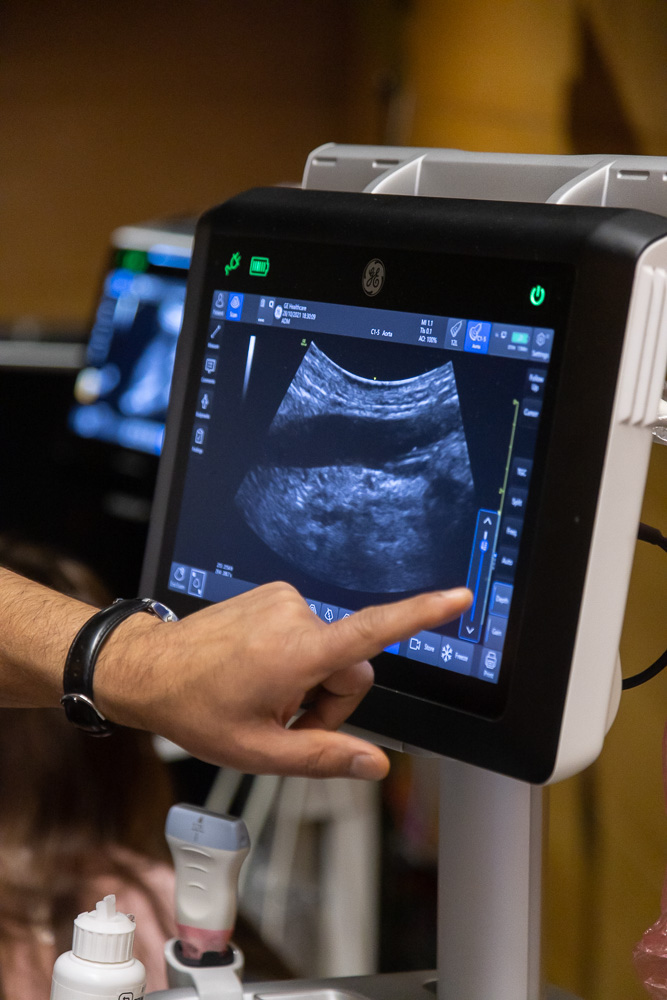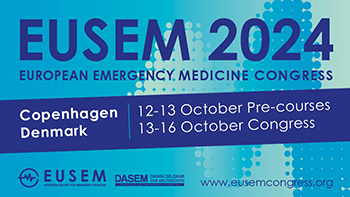
Format
This pre-course is offered in a half-day format on
Sunday September 17, 08:30 – 13:00 CEST at the Congress center in Barcelona.
Overview
You will have your choice of 4 modules out of a possible 19 different ultrasound applications to choose from. There will be a maximum of four participants per one instructor allowing each individual participant ample time with their hand on the probe.
Objective per module
Aorta and IVC:
- Describe the surface landmarks and transducer position necessary to
perform ultrasound of the abdominal aorta; - Understand the sonographic landmarks and anatomical relationships as it relates to the
aorta; - Discuss indications for performing abdominal aortic ultrasound.
Bodily fluid removal:
- Understand how pleural, pericardial and peritoneal fluid appear on
ultrasound. - Understand the sonographic landmarks and anatomical
relationships as they relate to commonly performed US guided
procedures in the emergency department – pericardiocentesis,
pleurocentesis, and paracentesis. - Use phantom models demonstrate ultrasound guided technique
Cardiac Transesophageal Echocardiogram:
- Understand the mechanics of the TEE probe and how to manipulate the
omniplane and flexion control wheels. - Identify relevant cardiac anatomy based on the planes of movement of the TEE transducer including omniplane angle adjustment, rotation of the probe, anteflexion, and retroflexion.
- Aquire and interpret sonographic images of the heart
(midesophageal 4-chamber, midesophageal long-axis, transgastric short axis). - Identify basic pathology including pericardial effusion,
hypovolemia, right and left heart dysfunction. - Understand the indications for TEE during emergency resuscitation as well as
contraindications to TEE use.

Cardiac Transthoracic Echocardiogram :
- Understand the utility of motion modality (M-mode) and learn its use
- Demonstrate the surface landmarks and transducer position necessary to
perform an echocardiogram in the ED. - Acquire and interpret sonographic images of heart (subcostal, parasternal long, parasternal short, and apical windows) 4. Identify pathologic conditions such as
pericardial effusion, gross wall motion abnormalities, and cardiac tamponade
DVT:
- Understand the sonographic landmarks and anatomical relationships as
they relate to the vasculature of the neck, upper extremity and lower
extremity - Acquire and interpret sonographic images of the internal jugular, femoral, basilic, brachial and axillary veins in live patient models.
- Demonstrate compression technique of upper and lower extremity veins.
eFast:
- Understand the surface landmarks for appropriate transducer positioning to perform the FAST examination.
- Understand the sonographic landmarks and anatomical relationships of the Heart, Liver,
Spleen and Bladder as they relate to the FAST examination. - Demonstrate the ability to identify and visualize the areas of potential intra-abdominal and thoracic spaces for free fluid to collect in on the FAST examination.
- Understand the sonographic findings and pitfalls for identifying life threatening, trauma conditions such as cardiac tamponade, hemo/pneumothorax, and intra-abdominal hemorrhage.
Equipment:
- Learn to be an expert on your own equipment.
- Learn how to safely connect and remove probes from their ports
- Learn how to switch between transducers.
- Learn and demonstrate how to store and review images.
- Demonstrate adjustments to controls ie; gain, depth, frequency in hands- on session. 6. Demonstrate how to properly document an ultrasound study by adding pt. information, text annotation and proper landmarks.
Emerging Technology
- TBC
Gallbladder & Renal:
- Describe the surface landmarks and transducer position necessary
perform a gallbladder and renal ultrasound examination - Understand the sonographic landmarks and anatomical relationships as it relates to
gallbladder and kidneys - Discuss the gall-bladder in it’s pathology
- Identify and detect pathology in the renal system. Describe the surface landmarks and transducer position necessary to perform a gallbladder examination
- Discuss the gallbladder ultrasound findings of cholelithiasis, cholecystitis, ands polyps.
Gastrointestinal:
- Understand the sonographic appearance of normal stomach, large and small bowel and pancreas, including normal anatomical structures and normal bowel peristalsis.
- 2. Describe transducer choices, scanning protocols and patient positions necessary to perform a gastrointestinal examination.
- Identify and detect gastrointestinal pathology such as ileus, pneumoperitoneum, appendicitis, colitis, diverticulitis, ileitis, intussusception or hernias.
- Describe common sites of intra-and retroperitoneal free air, systematic examination techniques and pitfalls for appendicitis, pneumoperitoneum, colitis, diverticulitis and hernia.
Head & Neck:
- Understand the normal sonographic appearance and anatomical landmarks of organs and structures in the head and neck region, including salivary glands, thyroid gland, the upper airway including larynx and trachea, upper esophagus, neck vessels and lymph node anatomy.
- Identify lymph nodes within the neck.
- Evaluate upper airway anatomy and understand how to detect endotracheal tube placement in esophagus or trachea 6. Understand anatomy of main neck vessels and their relation to other musculoskeletal structures.

Image Acquisition and Instrumentation:
- Enhance the understanding of the basic principles of ultrasound
- Apply these principles to the reduction of common artifacts and improvement of high quality diagnostic ultrasound images
- Understand the relationship between transducer position and image orientation
- Demonstrate the basic operator controls on the ultrasound system required` for image acquisition Enhance the understanding of the basic principles of ultrasound
- Apply these principles to the reduction of common artifacts and improvement of high quality diagnostic ultrasound images
Intelligent Ultrasound
- TBC
Musculoskeletal Upper:
- Discuss the advantages and disadvantages of diagnostic musculoskeletal ultrasound of the upper extremity
- Demonstrate the appearances of various tissues on diagnostic musculoskeletal ultrasound.
- Correctly apply ultrasound basic concepts so as to ensure proper visualization of musculoskeletal structures.
- Perform a dynamic musculoskeletal ultrasound of the shoulder to look for dislocation, and sub deltoid effusions.
- Perform a rotator cuff examination to isolate supraspinatus tendon.
Musculoskeletal Lower:
- Discuss the advantages and disadvantages of diagnostic musculoskeletal ultrasound of the upper extremity
- Demonstrate the appearances of various tissues on diagnostic musculoskeletal ultrasound.
- Correctly apply ultrasound basic concepts so as to ensure proper visualization of musculoskeletal structures.
- Perform a dynamic musculoskeletal ultrasound of the knee to look for effusions and torn tendons ( quadriceps and patellar)
- Evaluate achilles tendon for tear.
Ocular:
- Review and understand how sonography can reveal pathology of the eye and
to highlight its usefulness as a simple and cost-effective tool in investigating eye
symptoms. - Understand the normal ultrasound anatomy of the eye.
- Understand the relationship of the retina, optic nerve, and the ora serrata.
- Understand the appearance of retinal detachments and posterior vitreous detachments.
Peripheral Nerve Block:
- Discuss the science and practical performance of brachial plexus, axillary, and femoral blockade
- Learn the physiology and anatomy of the techniques, factors that influence success and complications
- Demonstrate approaches for peripheral nerve blocks in the upper and lower extremity
- Demonstrate peripheral nerve block on simulator under ultrasound guidance
Pulmonary:
- To review and understand the sonographic artifacts of normal and pathologic pulmonary conditions that give pulmonary ultrasound its diagnostic capacity. This includes but is not limited to pleural imaging, the “lung sliding sign”,B-line and comet tail identification for extravascular pulmonary congestion andpleural effusion imaging techniques.
- Demonstrate sonographic landmarks of the ribs, pleura, diaphragm and
lung parenchyma
Shock:
- Provide a sequenced approach to ultrasound in the medical shock patient.
- Demonstrate the surface landmarks and transducer position necessary to perform a shock scan
- Acquire and interpret sonographic images of the heart, and IVC. Review causes and potential responses to treatments of hypotension.
Vascular Access-Central:
- Understand the sonographic landmarks and anatomical relationships
as they relate to the vasculature of the neck, and groin. - Acquire and interpret sonographic images of the internal jugular, femoral, and axillary
veins in live patient models. - Demonstrate ultrasound guided cannulation on vascular simulator.
Vascular Access-Peripheral:
- Understand the sonographic landmarks and anatomical relationships
as they relate to the vasculature of the upper extremity. - Acquire and interpret sonographic images of the antecubital, cephalic, basilic, brachial
and axillary veins in live patient models. - Demonstrate ultrasound guided cannulation on vascular simulator.
For who
Emergency Physicians (consultants, trainees, Emergency Medicine Physician Assistant’s)
Educational Material
Pre-recorded lectures will be provided to the participants in advance. Online Video for each US application
Registration
The costs for this course are
€ 230* for physicians
€ 130* for nurses, paramedics, trainees and students
In combination with the Beginner Emergency Ultrasound Course you pay:
€ 399* for physicians
€ 266* for nurses, paramedics, trainees and students
*All prices exclusing VAT
Please register through your MyEUSEM account by clicking on the EUSEM Congress registration button. From the Pre-courses tab you can select the pre-courses you would like to join.
Faculty
Course Director: Michael Lambert, USA
Co-Director: Patrick Kishi, USA
- Rip Gangahar, UK
- Bob Jarman, UK
- Jim Connolly, UK
- Zeki Atesli, UK
- Aurthur Rosendaal, NL
- Hani Hariri, FR
- Nicolas Lim, SG
- Kim Poh Chan, SG
- Ernest Lim, SG
- Murali Kalyanasundaram, UK
- Victoria Vatsvåg, NO
- Eric Chin, USA
- Najib Nasrallah, IL
- Joseph Osterwalder, CH
- Renato Rapada, USA
- Norah Shemery, USA
- Nils Petter Oveland, NO
- Andrej Urumov, USA
- Shari Brand, USA
- Marcie Torres, USA
- Wayne Martini, USA
- Edmundo Chanter, USA
- Jennifer Luong, USA
| 08:30-09:00 | Introduction |
| 09:00-09:45 | Module 1 |
| 09:45-10:30 | Module 2 |
| 10:30-11:00 | Coffee break |
| 11:00-11:45 | Module 3 |
| 11:45-12:30 | Module 4 |
| 12:30-12:45 | Wrap up |
- Aorta and Inferior vena cava (IVC)
- Bodily fluid removal
- Cardiac Transthoracic Echo (TTE)
- Cardiac Transesophageal Echo (TEE)
- Deep vein Thrombosis (DVT)
- Extended Focused Assessment with sonography in trauma (eFAST)
- Equipment
- Gallbladder and Renal (Gb / Kid)
- Gastrointestinal (GI)
- Head and Neck
- Image Acquisition and Instrumentation
- Musculoskeletal (MSK) Upper
- Musculoskeletal (MSK) Lower
- Ocular (EYE)
- Peripheral Nerve Blocks (PNB)
- Pulmonary (Lung)
- Shock
- Vascular access – central (VAC)
- Vascular access – peripheral (VAP)
0845- Introduction
0900- Module 1 (choose from US Modules list in 2nd tab)
0945- Module 2 (choose from US Modules list in 2nd tab)
1030- Coffee Break
1100- Module 3 (choose from US Modules list in 2nd tab)
1145- Module 4 (choose from US Modules list in 2nd tab)
1230- Wrap Up
1245- Adjourn
- Aorta and Inferior vena cava (IVC)
- Bodily fluid removal
- Cardiac Transthoracic Echo (TTE)
- Cardiac Transesophageal Echo (TEE)
- Deep vein Thrombosis (DVT)
- Extended Focused Assessment with sonography in trauma (eFAST)
- Equipment
- Gallbladder and Renal (Gb / Kid)
- Gastrointestinal (GI)
- Head and Neck
- Image Acquisition and Instrumentation
- Musculoskeletal (MSK) Upper
- Musculoskeletal (MSK) Lower
- Ocular (EYE)
- Peripheral Nerve Blocks (PNB)
- Pulmonary (Lung)
- Shock
- Vascular access – central (VAC)
- Vascular access – peripheral (VAP)
